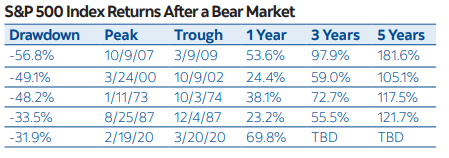In the first half of 2022, the S&P 500 Index entered into a bear market prompting some to ask: are the Canadian markets next? As a reminder, a bear market is often defined as a period in which stocks have declined by 20 percent from a previous peak over a period of usually two months or more.
While the Canadian markets have been more resilient to date, consider that bear markets are a normal part of the investing cycle. Since 1970, the S&P/TSX Composite Index has had an average annual return of over six percent (not including dividends reinvested) but this hasn’t come without an abundance of ups and downs. There have been nine bull markets, lasting 61 months (on average), leading to an average gain of 110 percent. This compares to eight bear markets, which lasted 10 months (on average), resulting in an average decline of 34 percent. The upturns, on balance, lasted longer than the downturns and took prices to much higher than their former peaks.
While declining asset values during bear market times may feel uncomfortable, it shouldn’t be a time for investors to run and hide. This is because the biggest up and down days often occur during down markets.1 Since 1928, the S&P 500 Index has had 350 trading days when the index fell by three percent or worse and 290 days when it surged by three percent or more in a single day. More than 90 percent of both volatile days have taken place during market corrections of 10 percent or worse and more than 80 percent have taken place during a bear market drawdown of 20 percent or worse.
By making rash decisions such as exiting the markets during a market drop, you’re likely to miss significant upward moves.
Consider also what happens after a bear market. It isn’t uncommon to see significant gains. Here are the worst bear markets for the S&P 500 Index since 1970 (chart), along with their ensuing one, three and five-year forward returns. While the timing is uncertain, we know that equity values eventually recover their positive tone in the same way as the cycle swings back towards more optimism.

Equities continue to be one of the best asset classes in which to grow wealth, but this is not without market fluctuations. This period of volatility and economic uncertainty will eventually pass. Longer-term investors should remember that portfolios have been positioned with the expectation that the equity markets will experience both ups and downs — this is a normal part of the investing journey. Continue to look forward to better days ahead.

.webp)
.webp)